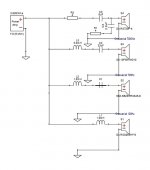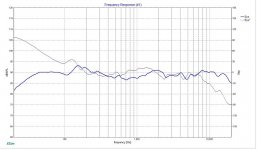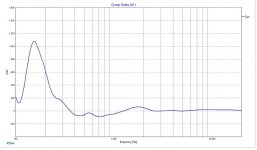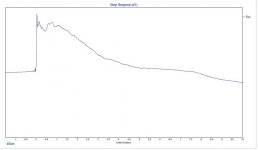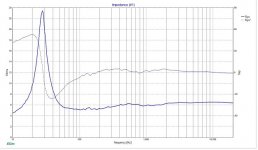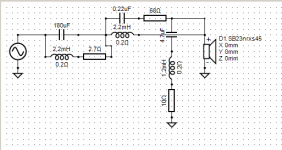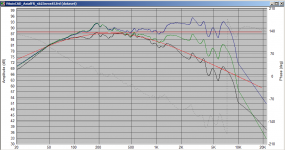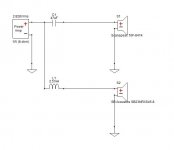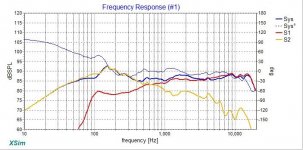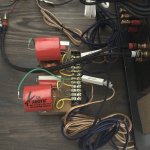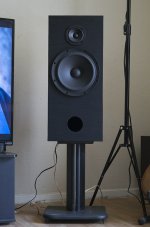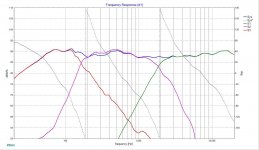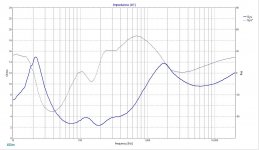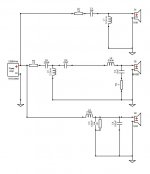
So just for sake of practicing, I decided to design a 4 way crossover from scratch. Drivers are :
Tweeter : Dayton Audio RST28F-4
Mid : ScanSpeak 10F/8414G10
Woofer : SBA SB23NRXS45-8
LF : Dayton Audio RSS265HF-8
the only reason i chose these is because i had the frd/zma for them !
it is a simple 1st order crossover crossed at 100/700/7000Hz.
So tell me how i did, why good, why bad and what would you change ?
Thanks
A.
Attachments
You are wasting your time with Mickey Mouse circuits.
Try designing something good.
Replicate this Troels Gravesen 3 way with the SB bass, the scan mid and the tweeter. Try to get the same slopes.
SBAcoustics-3WC
If you are struggling for a starting place, try this configuration for some typical component values back from when he gave it away:
SEAS-3-Way-Classic
You might end up with something you fancy building. I enjoy trying Troels circuits with different drivers. It's the idea that matters.
Try designing something good.
Replicate this Troels Gravesen 3 way with the SB bass, the scan mid and the tweeter. Try to get the same slopes.
SBAcoustics-3WC
If you are struggling for a starting place, try this configuration for some typical component values back from when he gave it away:
SEAS-3-Way-Classic
You might end up with something you fancy building. I enjoy trying Troels circuits with different drivers. It's the idea that matters.
the SB23NRXS45-8 will need at least a 2nd order HP filter, look at the breakup zone on its FR graph;
you haven't said whether you took baffle step into account...
not much point in zobelling the tweeter, if you're using a flat baffle I'd go 2nd order for the tweeter
no baffle step here, i know w 1st order i need a baffle step but it s just training.
I have a working two way with SBA and SS, and as suggested i used a zobel on woofer to help w breakup and still keep it 1st order, i think that would do trick here as well instead of going 2nd order. the reason i skipped that here is that the graph look flat and i thought i can get away w it.
System7 suggested XO from Troels designs have a 2nd order on tweeter as well, will study it more
You are wasting your time with Mickey Mouse circuits.
Try designing something good.
Replicate this Troels Gravesen 3 way with the SB bass, the scan mid and the tweeter. Try to get the same slopes.
SBAcoustics-3WC
If you are struggling for a starting place, try this configuration for some typical component values back from when he gave it away:
SEAS-3-Way-Classic
You might end up with something you fancy building. I enjoy trying Troels circuits with different drivers. It's the idea that matters.
the reason i start from scratch was to learn, but having an starting point will also help, from my understanding Troels SBA crossover has a 1st order on woofer and 2nd on mid and tweeter, it would help if i had the FRD files for this so i could simulate and see how it works, i may need to start tracing
thanks for the input guys, lemme know if you have any other suggestions, gonna start working on my homework.
I dislike all the CAD sims I have seen. They all seem quite unintuitive to me. They seem to all stem from Linux open source code.
Visaton Boxsim has a much shallower learning curve IMO:
Software | Visaton
Just stick any project bpj file you want from this huge library of designs in the projekte folder and you get the whole thing to play with.
Boxsim Projektdatenbank
I don't think 2 wege is difficult to translate to two way! You can import frd and zma files for non-visaton drivers and guess acoustic centre. But really, seen one woofer, you seen 'em all...
FWIW, acoustic centre is usually near the middle of the driver voicecoil. It's important for phase. Visaton files include the figure, and you soon spot the pattern.
Visaton Boxsim has a much shallower learning curve IMO:
Software | Visaton
Just stick any project bpj file you want from this huge library of designs in the projekte folder and you get the whole thing to play with.
Boxsim Projektdatenbank
I don't think 2 wege is difficult to translate to two way! You can import frd and zma files for non-visaton drivers and guess acoustic centre. But really, seen one woofer, you seen 'em all...
FWIW, acoustic centre is usually near the middle of the driver voicecoil. It's important for phase. Visaton files include the figure, and you soon spot the pattern.
I'm having a bit of a play just with the SB driver, without having put baffle step in the equation and I must say it will require a really complex filter to try and get it doing a 1st order acoustic at 100 and 700Hz!! I like a challenge but it does not look very feasible.
That is one of the misconceptions that people have. A first order crossover doesn't mean first order electrical. A true first order crossover is far more complex than a cap or an inductor. If I manage to pull something off (for that one driver) I will post it, but I'm not holding my breath
Tony.
That is one of the misconceptions that people have. A first order crossover doesn't mean first order electrical. A true first order crossover is far more complex than a cap or an inductor. If I manage to pull something off (for that one driver) I will post it, but I'm not holding my breath
Tony.
I did try Vituix CAD. I hadn't a clue what was going on even with the supplied file from somebody here. 
If I want to know what to do with a driver, I usually just go to Mr. Troels Gravesen. DIY-Loudspeakers
A safe pair of hands as us Cricket fans say. Our own Michael Chua is a clever bloke too.
Seas ER18RNX with 27TDFC
Speaker of the Year, IMO. Genius. (OK, the tweeter section could be better... but clever.)
If I want to know what to do with a driver, I usually just go to Mr. Troels Gravesen. DIY-Loudspeakers
A safe pair of hands as us Cricket fans say. Our own Michael Chua is a clever bloke too.
Seas ER18RNX with 27TDFC
Speaker of the Year, IMO. Genius. (OK, the tweeter section could be better... but clever.)
OK I had a play. Note that this is just the traced manufacturer curves. No baffle effects, no changes to reflect a proper alignment of the driver. I chose 88db as the target. Also this does not take into consideration how it will mate with other drivers!! It was purely an exercise in seeing whether I could massage it to fitting a 1st order slope at 100Hz HP and 700 Hz lp.
I modeled in vituixcad but did the overlays in speaker workshop. Black is with the network shown, blue is the original driver response, and green is the OP's single 1.2mH coil.
Tony.
I modeled in vituixcad but did the overlays in speaker workshop. Black is with the network shown, blue is the original driver response, and green is the OP's single 1.2mH coil.
Tony.
Attachments
Ouch, that seems complicated for a first order roll off.
Aatto, do you want to build passive crossovers or is DSP also fine? DSP is easier because there is no interaction between different crossover components or between the components and driver impedance. Shaping the transfer functions of the individual drivers and time aligning them (matching phase) also can be done separately. Just add or modify filters until the transfer function of the individual drivers matches some target curve. Then add delay for matching phase. You do need measuring equipment though, for measuring the transfer function after each filter modification, because many crossover design programs do not support simulation of DSP filters.
Aatto, do you want to build passive crossovers or is DSP also fine? DSP is easier because there is no interaction between different crossover components or between the components and driver impedance. Shaping the transfer functions of the individual drivers and time aligning them (matching phase) also can be done separately. Just add or modify filters until the transfer function of the individual drivers matches some target curve. Then add delay for matching phase. You do need measuring equipment though, for measuring the transfer function after each filter modification, because many crossover design programs do not support simulation of DSP filters.
Last edited:
I read long ago that in order to do a true first order acoustic rolloff it usually requires a quite complex crossover (unless you have drivers that are completely flat for a long way either side of the intended pass band).
I'd never actually tried it, so the above is a first attempt and there may well be a better way, but as can be seen a simple electrical first order circuit doesn't cut it with this driver
Tony.
I'd never actually tried it, so the above is a first attempt and there may well be a better way, but as can be seen a simple electrical first order circuit doesn't cut it with this driver
Tony.
I don't have shares in Visaton, but I think Boxsim supports electronic/DSP crossovers, just not something I have used in the toolkit. 
I tend to look at designs, maybe sim them, and ask myself what is good about them.
This is something ancient by W. Marshall Leach, one of the great theoreticians.

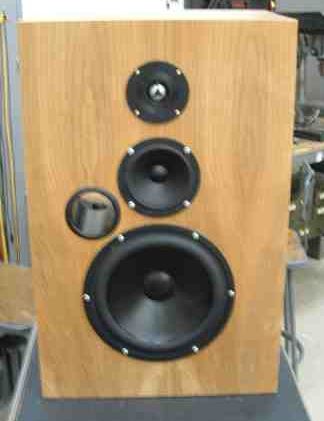
For those that are weak on theory, all good three ways look like this on Steen Duelund target curves if you want everything else to line up nicely:
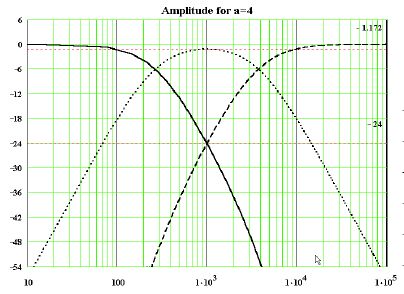
Don't argue about it with me. It's function of a complex variable, great mathematics, and it is proved for eternity like the Pythagoras Theorem. So just don't!
Marshall Leach has done a "proper job" on impedance correction on the bass there. It's not just an RC, is it? He has chosen flat and easy drivers. Lot to like. Very educational.
Now revisit Michael Chua's brilliant Starling. Do you get what is great about the bass section? Do the sim!
Seas ER18RNX with 27TDFC
I tend to look at designs, maybe sim them, and ask myself what is good about them.
This is something ancient by W. Marshall Leach, one of the great theoreticians.
For those that are weak on theory, all good three ways look like this on Steen Duelund target curves if you want everything else to line up nicely:
Don't argue about it with me. It's function of a complex variable, great mathematics, and it is proved for eternity like the Pythagoras Theorem. So just don't!
Marshall Leach has done a "proper job" on impedance correction on the bass there. It's not just an RC, is it? He has chosen flat and easy drivers. Lot to like. Very educational.
Now revisit Michael Chua's brilliant Starling. Do you get what is great about the bass section? Do the sim!
Seas ER18RNX with 27TDFC
Ouch, that seems complicated for a first order roll off.
Aatto, do you want to build passive crossovers or is DSP also fine? DSP is easier because there is no interaction between different crossover components or between the components and driver impedance. Shaping the transfer functions of the individual drivers and time aligning them (matching phase) also can be done separately. Just add or modify filters until the transfer function of the individual drivers matches some target curve. Then add delay for matching phase. You do need measuring equipment though, for measuring the transfer function after each filter modification, because many crossover design programs do not support simulation of DSP filters.
I already build some w miniDSP, and was able to do a Harsch XO w my FAST system, and if i ever want to build such 4 way monster I would go with DSP for LFs and Passive for HF, mr Troels did same thing in one his speakers if i m not mistaking or was it someone else ?
anyhow this is just a pure training attempt to learn about more complex setup and at the moment i m not planning to build such speaker, i did some simple working passive XOs before and i m just trying to learn something here
I read long ago that in order to do a true first order acoustic rolloff it usually requires a quite complex crossover (unless you have drivers that are completely flat for a long way either side of the intended pass band).
I'd never actually tried it, so the above is a first attempt and there may well be a better way, but as can be seen a simple electrical first order circuit doesn't cut it with this driver
Tony.
I can see what you r saying, and as you said it depends on driver and how they behave, your attempt on the crossover was very interesting, i m still studying it to learn the effect of each step.
talking about 1st order, i did designed the simplest 1st order for my FAST and it is in my current system and i m really enjoying it, it was running w miniDSP
and mr Harsch XO but i prefer the passive XO, anyhow you can see the attached files. i just added a zobble to woofer and some padding to FR.
But I know this is not the case all the time and i wouldn't get away w it in other case. could it be better ? absolutely. but I ll learn and make it better.
Attachments
Last edited:
I was going to say that active would be the way to go with the lower drivers. I've got effectively a three way (separate cabs for woofers), with an active cross at 270 hz between the woofer cab and the MTM with a passive crossover on the MTM. It works quite well.
Playing with this sort of thing in sims is the best way to get a feel for how you can alter the response of a driver to match your goals, you can learn an awful lot before you even purchase a component, and when you do purchase some components you have a much better chance of it being right, or close to right the first time
If you have measurements on that baffle and impedance measurements taken in the box as well, then you have all that you need to start playing and making improvements. You could try designing a 2nd order and a 4th order (acoustic not electrical) as well, make each and listen to them and see how they sound. When you nail it you will be amazed at the difference.
My MTM's started off with just a cap on the tweeter with the M's running full range and they sounded pretty good like that, then they progressed to a 2nd order acoustic crossover, and sounded better, but I was still looking for more. I then went to a 4th order acoustic (both the second and fourth order were bessel) and it was a quantum leap. I've been listening to that version for about 8 years now, but I'm looking at doing a new crossover now I've learned a few more tricks from seeing what others have done, and playing with sims.
Tony.
anyhow this is just a pure training attempt to learn about more complex setup and at the moment i m not planning to build such speaker, i did some simple working passive XOs before and i m just trying to learn something here
Playing with this sort of thing in sims is the best way to get a feel for how you can alter the response of a driver to match your goals, you can learn an awful lot before you even purchase a component, and when you do purchase some components you have a much better chance of it being right, or close to right the first time
I can see what you r saying, and as you said it depends on driver and how they behave, your attempt on the crossover was very interesting, i m still studying it to learn the effect of each step.
talking about 1st order, i did designed the simplest 1st order for my FAST and it is in my current system and i m really enjoying it, it was running w miniDSP
and mr Harsch XO but i prefer the passive XO, anyhow you can see the attached files. i just added a zobble to woofer and some padding to FR.
But I know this is not the case all the time and i wouldn't get away w it in other case. could it be better ? absolutely. but I ll learn and make it better.
If you have measurements on that baffle and impedance measurements taken in the box as well, then you have all that you need to start playing and making improvements. You could try designing a 2nd order and a 4th order (acoustic not electrical) as well, make each and listen to them and see how they sound. When you nail it you will be amazed at the difference.
My MTM's started off with just a cap on the tweeter with the M's running full range and they sounded pretty good like that, then they progressed to a 2nd order acoustic crossover, and sounded better, but I was still looking for more. I then went to a 4th order acoustic (both the second and fourth order were bessel) and it was a quantum leap. I've been listening to that version for about 8 years now, but I'm looking at doing a new crossover now I've learned a few more tricks from seeing what others have done, and playing with sims.
Tony.
any improvements ?
Ok, Here's a 2.5 way XO, I used SBA NRX as a sub, I know it is a woofer with a wide FR but why not it is an exercise, the Mid is Volt 228.8 and Tweeter is 9130 with LR2.
Tried to hit Steen Duelund target curves as system7 suggested, so any improvements since last time or any suggestions ? how the impedance curve look ? I m abit concern about very mild dip between 1k and 2k, I know I can work around it tho.
Ok, Here's a 2.5 way XO, I used SBA NRX as a sub, I know it is a woofer with a wide FR but why not it is an exercise, the Mid is Volt 228.8 and Tweeter is 9130 with LR2.
Tried to hit Steen Duelund target curves as system7 suggested, so any improvements since last time or any suggestions ? how the impedance curve look ? I m abit concern about very mild dip between 1k and 2k, I know I can work around it tho.
Attachments
Last edited:
I'm a bit concerned about the low freq impedance. I've nevervseen a resistor in parallel with a shunt cap. Not sure how that will affect the two shunt caps in paralell. But I'll assume they are effectively around the 50uf mark.
What's the impedace curve like without them?
Tony.
What's the impedace curve like without them?
Tony.
If you originally tried Vituixcad 1.x try 2.x. It's a major rewrite that switched from gluing together predefined ladder networks to full free-form spice style circuit design, and in the last few months it has improved a lot further as the author is constantly pumping out minor revisions.I did try Vituix CAD. I hadn't a clue what was going on even with the supplied file from somebody here.
Hands down the best free crossover CAD software I've seen or used, I used it exclusively (together with ARTA for measurements) for my last speaker design, and the results were spot on to its predictions. It can also do a lot more than just the crossover, it also does T/S box simulation, nearfield/farfield splicing including a 3D diffraction model, off axis, power response and polar response patterns etc if you provide more than just on axis measurements to it...
I started on V1.x then switched to V2.x when it came out part way through the design process, I found both very easy to use and rarely refer to the manual.
Last edited:
You are also missing driver distances. Once you add that in all your phase matching will go to hell.
Best,
Erik
He's right. your inputs are crap = crap result.
- Status
- This old topic is closed. If you want to reopen this topic, contact a moderator using the "Report Post" button.
- Home
- Loudspeakers
- Multi-Way
- Crossover exercise !
